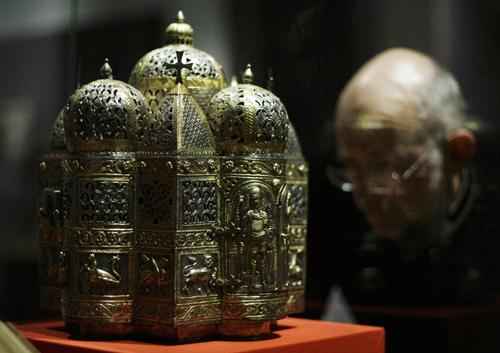London exhibit of Byzantine art trumps bureaucracy

A man looks at a 12th century perfume brazier in the form of a domed building, from Constantinople or Italy, on display in the Byzantium 330-1453 exhibition at the Royal Academy of Arts in London, Tuesday, Oct. 21, 2008. Matt Dunham, The Associated Press
Oct 22, 2008
LONDON – A dazzling exhibition of a thousand years of Byzantium’s art is in the final stages of assembly in London after months of labyrinthine complications.
In fact the very definition of the word byzantine.
This effort to bring Byzantium to Britain culminates in the opening Saturday of a major exhibition at the Royal Academy of Arts. And on Tuesday, with four days remaining before the official opening, the trials had not ended.
“This was one of the most complicated and difficult exhibitions we have had to put together in recent years,” said Adrian Locke, the Royal Academy’s acting director of exhibitions.
Institutions in Russia, Ukraine, Greece and Egypt did not easily give up their treasures for loans. And they were cautious about the implications of Britain’s recent legislation granting institutional loans immunity from seizure.
Get The Daily Illini in your inbox!
“It’s been quite a process in order to get some of these objects here, and multi visits and multi layers of red tape have had to be passed to get these objects,” Locke said in an interview.
The gallery had been through similar issues with its previous blockbuster, “From Russia,” which was complicated by a low point in British-Russian relations over the poisoning of former agent Alexander Litvinenko. To pave the way for art, Parliament rushed through legislation to protect institutional loans from seizure.
This week, the gallery was still waiting for a minister’s signature in Egypt to release priceless icons from the monastery of St. Catherine in Sinai to come to London.
“We’ve been a little bit unfortunate that the minister of culture, who has to sign the documents, has been away from Egypt,” he said in an interview.
The exhibition traces the development of art from the foundation of Constantinople – now Istanbul – in 330 to the fall of the capital in 1453. Intricately worked objects illustrate how Christianity and imperial power shaped Byzantine art, which in turn influenced Europe’s Renaissance.
It is the first major exhibition in London devoted to Byzantium in the half century since the Victoria and Albert Museum’s “Treasures of Byzantium” show.
“The V&A; exhibition in 1958 was very much a connoisseur’s view of Byzantium,” said Robin Cormack, the curator.
“It was the kind of art history that I was educated into, which is that all you have to do with a work of art is give it a date, say where it has come from and it will speak for itself.
“Now we realize that everyone comes to works of art with baggage. … I think we recognize much more the political, the religious attitudes that we have and how that dictates how we look at works of art.”
Europe seems to perpetually revise its view of Byzantium, the eastern and long-lived half of the Roman Empire.
Liudprand, bishop of Cremona, was dazzled by the roaring of gilded lions and the twittering of gilded birds around the imperial throne when he made his first visit to Constantinople in 949.
Edward Gibbon, the 18th-century historian of the Roman Empire, dismissed Byzantium as “the triumph of barbarism and religion.”
Two of the star exhibits are now known as treasures of Venice: a censer built in the form of a church, and a gold enamel icon of the archangel Michael.
“It’s a complicated period, this, because the objects have such complicated histories,” Cormack said. “They are not just made somewhere and used once.”
He points to the “Man of Sorrows” from Rome’s church of S. Croce in Gerusalemme.
“I chose the micro-mosaic of the Man of Sorrows because it’s made for probably a rich patron, given as a gift to a monastery, taken from the monastery to Italy, and then turned into an extraordinary important relic in Rome,” Cormack said. “That’s an amazing history for one object to have.”
“Byzantium” opens Saturday and continues through March 22.





